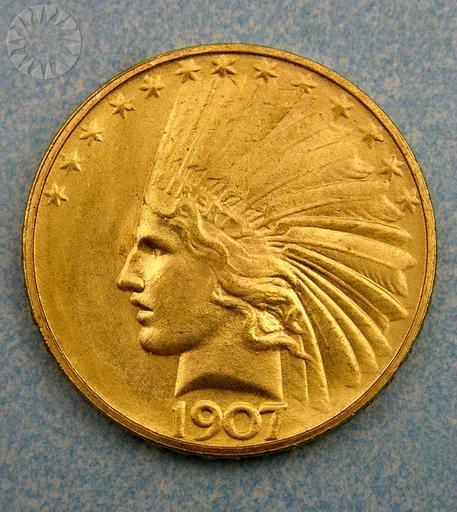MAKE A MEME
View Large Image

| View Original: | United_States,_10_Dollars,_1907_(pattern).jpg (571x640) | |||
| Download: | Original | Medium | Small | Thumb |
| Courtesy of: | www.flickr.com | More Like This | ||
| Keywords: legendary coins legendarycoins numismatics money smithsonian probably public domain probablypublicdomain round circle SI Neg. 2005-27304. Date: 9/1/2005...In 1905 President Theodore Roosevelt asked sculptor Augustus Saint-Gaudens to lead an effort to redesign American coinage. Saint-Gaudens developed a design that many consider the most beautiful American coin ever conceived. In addition to this $20 coin, Saint-Gaudens also redesigned this $10 coin, or eagle. Although the design has always been considered subordinate to his design for the $20 coin, it deserves close scrutiny. It bears witness to the labors of a gifted artist, working in ill health and under great pressure, and creating beauty almost at his final moment..Saint-Gaudens was working against time and knew it. By the time he turned his attention to the ten-dollar coin, he was already gravely ill, with only a few months to live. So he recycled some earlier ideas. He reused a head of Victory that he had originally created for the Sherman Monument in New York City, adding a war bonnet. The result was fanciful, and Saint-Gaudens's logical equation of Liberty with a Native American was no more convincing than Longacre's version on the Indian Head cent. .But from an artistic point of view, it worked. The eagle on the reverse was also recycled, this time from President Roosevelt's inaugural medal. The coin shown here was struck in modest quantity-about thirty-two thousand pieces. However, all but forty-two were ultimately melted down..Click here to view the obverse...Credit: Tom Mulvaney (Smithsonian Institution) SI Neg. 2005-27304. Date: 9/1/2005...In 1905 President Theodore Roosevelt asked sculptor Augustus Saint-Gaudens to lead an effort to redesign American coinage. Saint-Gaudens developed a design that many consider the most beautiful American coin ever conceived. In addition to this $20 coin, Saint-Gaudens also redesigned this $10 coin, or eagle. Although the design has always been considered subordinate to his design for the $20 coin, it deserves close scrutiny. It bears witness to the labors of a gifted artist, working in ill health and under great pressure, and creating beauty almost at his final moment..Saint-Gaudens was working against time and knew it. By the time he turned his attention to the ten-dollar coin, he was already gravely ill, with only a few months to live. So he recycled some earlier ideas. He reused a head of Victory that he had originally created for the Sherman Monument in New York City, adding a war bonnet. The result was fanciful, and Saint-Gaudens's logical equation of Liberty with a Native American was no more convincing than Longacre's version on the Indian Head cent. .But from an artistic point of view, it worked. The eagle on the reverse was also recycled, this time from President Roosevelt's inaugural medal. The coin shown here was struck in modest quantity-about thirty-two thousand pieces. However, all but forty-two were ultimately melted down..Click here to view the obverse...Credit: Tom Mulvaney (Smithsonian Institution) | ||||